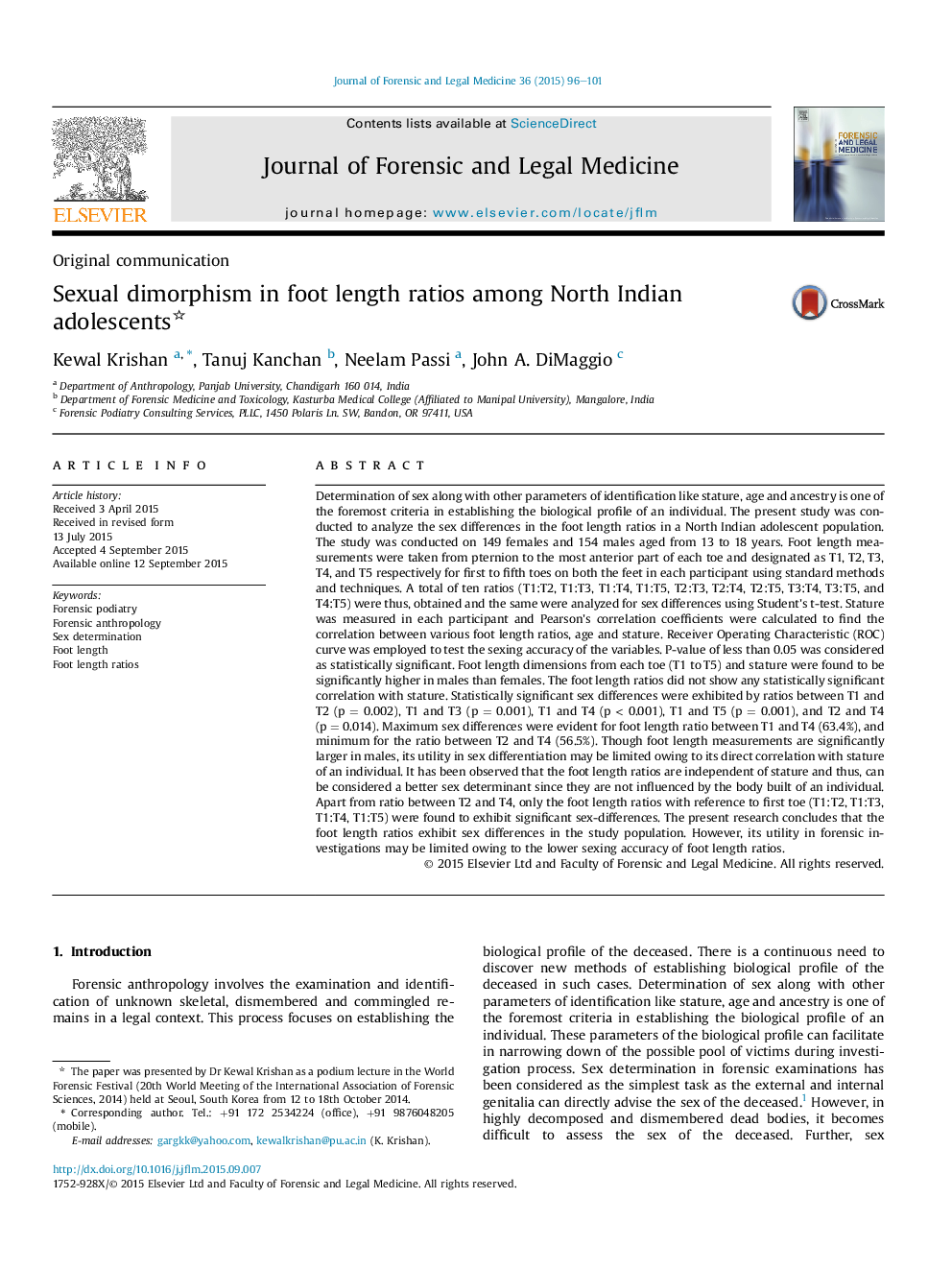| کد مقاله | کد نشریه | سال انتشار | مقاله انگلیسی | نسخه تمام متن |
|---|---|---|---|---|
| 101677 | 161288 | 2015 | 6 صفحه PDF | دانلود رایگان |
• The study evaluates the sexual dimorphism in foot length ratios (FLRs).
• Ten ratios (T1:T2, T1:T3, T1:T4, T1:T5, T2:T3, T2:T4, T2:T5, T3:T4, T3:T5, and T4:T5) were obtained.
• Student's t-test and ROC curve were employed for sexing accuracy of the variables.
• Sex differences were exhibited by T1 and T2, T1 and T3, T1 and T4, T1 and T5, and T2 and T4.
• FLRs are better sex determinant since not influenced by the body built of an individual.
Determination of sex along with other parameters of identification like stature, age and ancestry is one of the foremost criteria in establishing the biological profile of an individual. The present study was conducted to analyze the sex differences in the foot length ratios in a North Indian adolescent population. The study was conducted on 149 females and 154 males aged from 13 to 18 years. Foot length measurements were taken from pternion to the most anterior part of each toe and designated as T1, T2, T3, T4, and T5 respectively for first to fifth toes on both the feet in each participant using standard methods and techniques. A total of ten ratios (T1:T2, T1:T3, T1:T4, T1:T5, T2:T3, T2:T4, T2:T5, T3:T4, T3:T5, and T4:T5) were thus, obtained and the same were analyzed for sex differences using Student's t-test. Stature was measured in each participant and Pearson's correlation coefficients were calculated to find the correlation between various foot length ratios, age and stature. Receiver Operating Characteristic (ROC) curve was employed to test the sexing accuracy of the variables. P-value of less than 0.05 was considered as statistically significant. Foot length dimensions from each toe (T1 to T5) and stature were found to be significantly higher in males than females. The foot length ratios did not show any statistically significant correlation with stature. Statistically significant sex differences were exhibited by ratios between T1 and T2 (p = 0.002), T1 and T3 (p = 0.001), T1 and T4 (p < 0.001), T1 and T5 (p = 0.001), and T2 and T4 (p = 0.014). Maximum sex differences were evident for foot length ratio between T1 and T4 (63.4%), and minimum for the ratio between T2 and T4 (56.5%). Though foot length measurements are significantly larger in males, its utility in sex differentiation may be limited owing to its direct correlation with stature of an individual. It has been observed that the foot length ratios are independent of stature and thus, can be considered a better sex determinant since they are not influenced by the body built of an individual. Apart from ratio between T2 and T4, only the foot length ratios with reference to first toe (T1:T2, T1:T3, T1:T4, T1:T5) were found to exhibit significant sex-differences. The present research concludes that the foot length ratios exhibit sex differences in the study population. However, its utility in forensic investigations may be limited owing to the lower sexing accuracy of foot length ratios.
Journal: Journal of Forensic and Legal Medicine - Volume 36, November 2015, Pages 96–101
